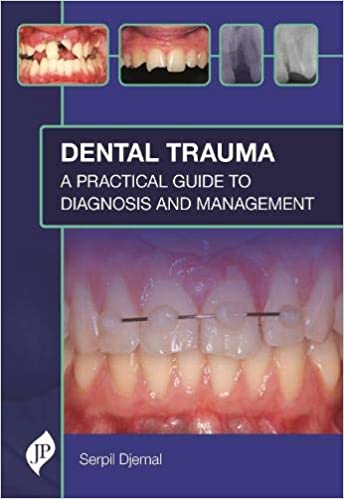Book Review - Dental Trauma: A Practical Guide to Diagnosis and Management by Serpil Djemal
A review by Dr Asma Qureshi (Dentistry BDS, 2006), President of Barts and The London Dental Club

This is a comprehensive yet concise, colour illustrated, step by step textbook guide, covering all the basics and complexities any dentist, specialist or dental student would need to equip them in the effective management of dental trauma. From first principles to long term consequences of dental trauma, the book is organised into 14 neat chapters. Every type of dental fracture and luxation as well as dentoalveolar fractures are systematically categorised and covered in detail. The straightforward contents and simple index allow the reader to easily navigate and find any subtopic.
The layout is well-structured. Each chapter follows a pattern which includes an introduction, epidemiology, assessment, diagnosis and management of the dental injury, allowing the reader to maintain an orderly approach to the topic. Repetition of the follow-up mantra and post operative care are a beneficial learning reinforcement with specific protocols laid out for each injury type. The text is clear, informative and relevant. The content is detailed and is well balanced with a plethora of coloured photographs, radiographs, tables and diagrams, all illustrating and supporting the text appropriately throughout.
Several case studies (a total of 35) are well presented, thereby giving the reader a complete guidance on how to practically manage all the various traumatic dental injuries. What is extremely impressive is that the author has a case base of 1769 patients treated at the Specialist Adult Dental Trauma Clinic at Kings College Hospital between 2012 and 2018. The author has cited a total of 3912 teeth which sustained 4062 traumatic dental injuries which have been used to give epidemiology and from which the case studies for each dental trauma have been selected and demonstrated.
The experience and skill of the author and contributors shine through. It is helpful that there are practical tips in the book for dental practitioners to assist with the hands-on treatment of dental injuries including advice on how to reposition teeth, splinting teeth, tips on the use of temporary splints and alternatives to hold repositioned teeth in place and the use of polytetrafluoroethylene (PTFE) tape to separate adjacent teeth when reattaching tooth fragments or bonding composite resin. The author mentions other consequences of dental trauma and its management for example, bleaching and Cvek pulpotomy, helpful for practitioners who may have limited knowledge or who may lack confidence in these techniques.
It is extremely useful that the book covers injuries on mature teeth with closed apices as well as immature teeth with open apices and addresses all dental and root fractures in great detail. Although it might be worthwhile if the book had some case studies where treatment had not been successful, the complications of dental trauma are actually discussed in full depth in the final chapter, with explanatory diagrams depicting potential long-term issues. Majority of the case studies also highlight postoperative follow up, where in some cases, sequalae of dental trauma had manifested and subsequent treatment was carried out.
Overall, the guidance and practical advice is very clear and easy to understand, which is especially important for a topic that most dental practitioners find daunting in clinical practice. Each section has a further reading segment directing the reader to evidence-based dentistry in the form of textbooks, guidelines and published research. The book is not text heavy and is complemented with many appropriate pictures and diagrams to accompany the text, making it a very comprehensible and relevant read on an important topic in clinical dentistry. A must have reference book for all clinical dental practitioners.
Dr Asma Qureshi
President of Barts and the London Dental Club, 2020-2022
The book can be ordered here.